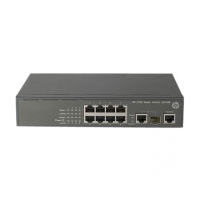29
Ste
Command
Remarks
3. Configure a preference for
RIP.
preference [ route-policy
route-policy-name ] value
The default setting is 100.
Configuring RIP route redistribution
Perform this task to configure RIP to redistribute routes from other routing protocols, including OSPF, IS-IS,
BGP, static, and direct.
To configure RIP route redistribution:
Ste
Command
Remarks
1. Enter system view.
system-view N/A
2. Enter RIP view.
rip [ process-id ] [ vpn-instance
vpn-instance-name ]
N/A
3. Redistribute routes from
another routing protocol.
import-route protocol [ process-id
| all-processes | allow-ibgp ] [ cost
cost | route-policy
route-policy-name | tag tag ] *
By default, RIP route redistribution
is disabled.
This command can redistribute
only active routes. To view active
routes, use the display ip
routing-table protocol command.
4. (Optional.) Configure a
default cost for redistributed
routes.
default cost value The default setting is 0.
Tuning and optimizing RIP networks
Configuration prerequisites
Before you tune and optimize RIP networks, complete the following tasks:
• Configure IP addresses for interfaces to ensure IP connectivity between neighboring nodes.
• Configure basic RIP.
Configuring RIP timers
You can change the RIP network convergence speed by adjusting the following RIP timers:
• Update timer—Specifies the interval between route updates.
• Timeout timer—Specifies the route aging time. If no update for a route is received within the aging
time, the metric of the route is set to 16.
• Suppress timer—Specifies how long a RIP route stays in suppressed state. When the metric of a
route is 16, the route enters the suppressed state. A suppressed route can be replaced by an
updated route that is received from the same neighbor before the suppress timer expires and has a
metric less than 16.

